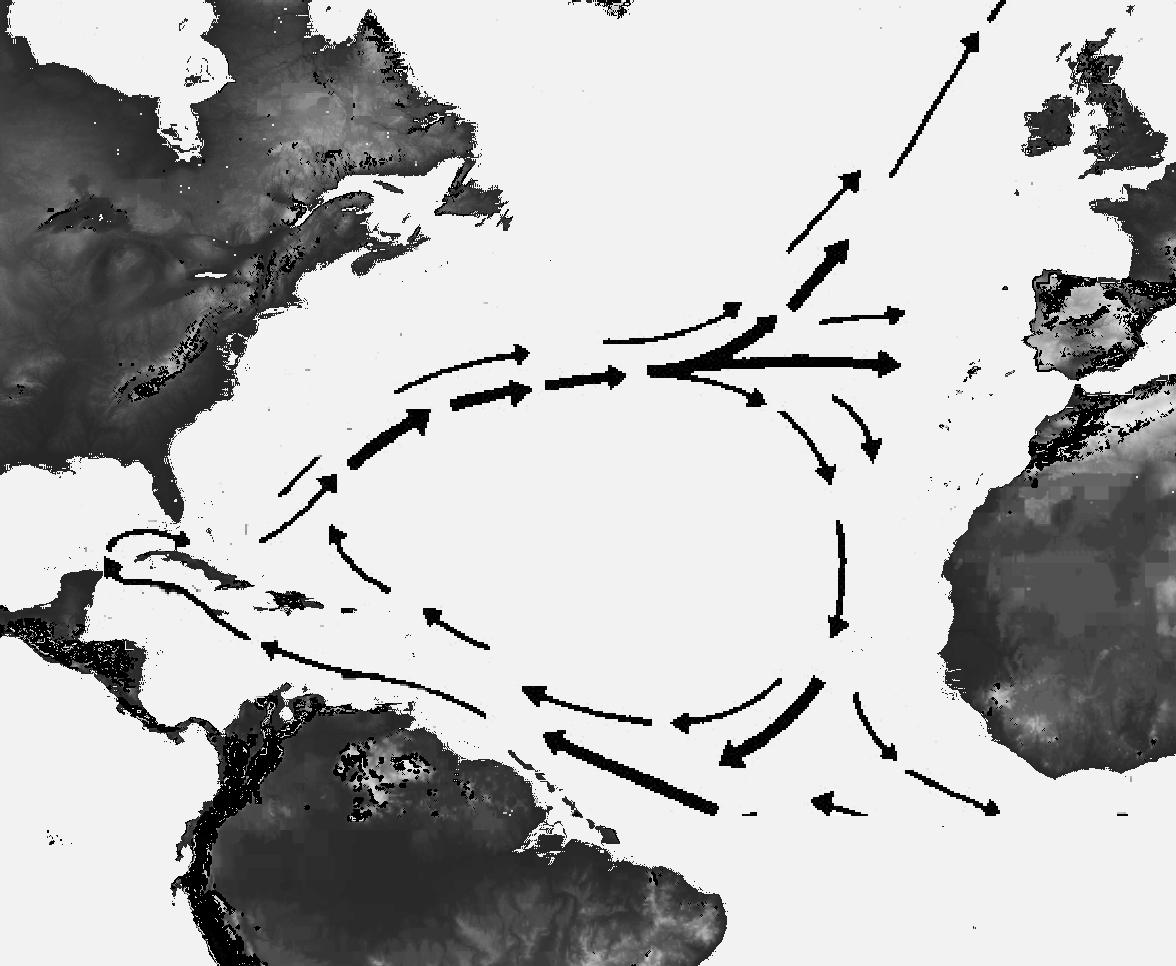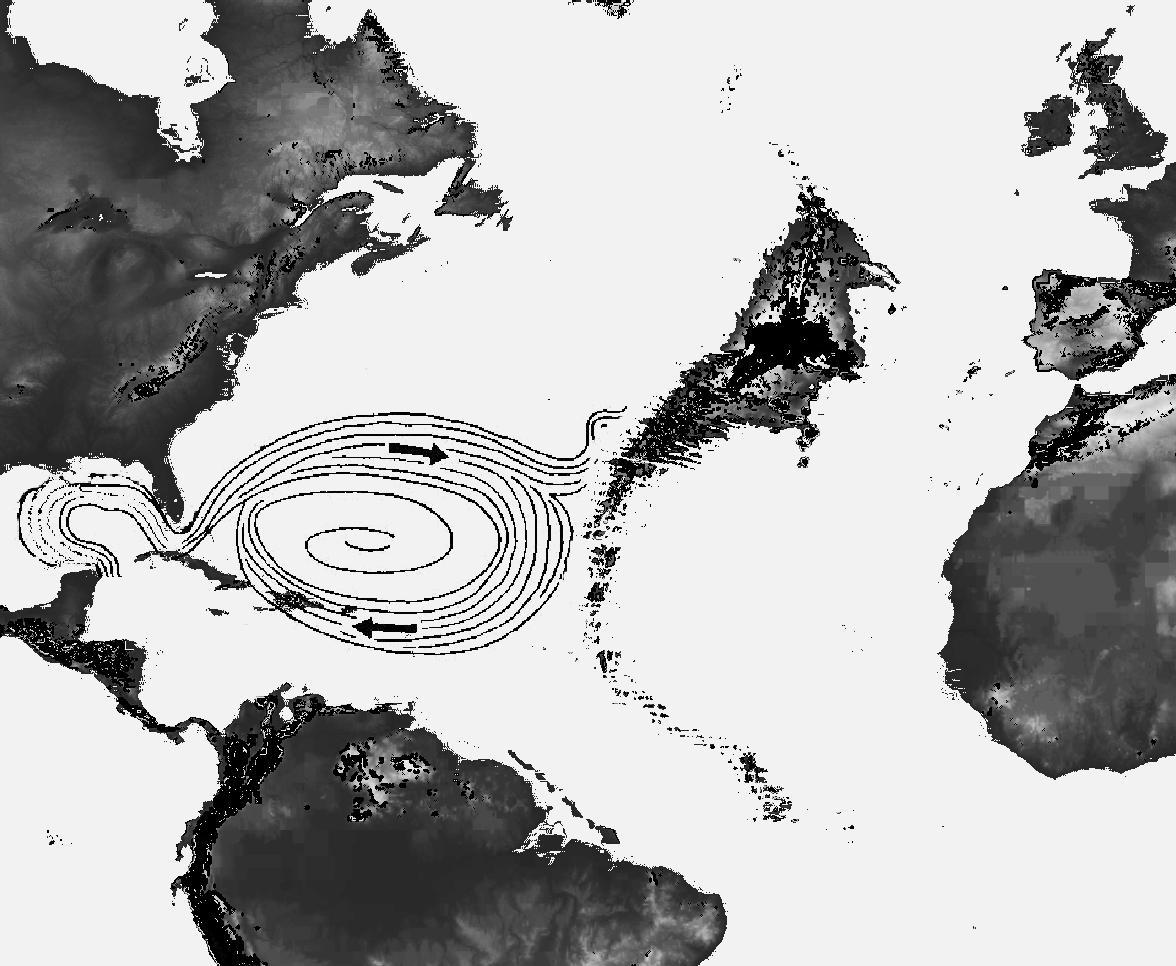Was This Atlantis?
Examination of the possible location and the reason of its disappearance.
Version Française.
The Gulf-Stream, was it once reaching Europe?
We
know all of the Gulf-Stream, the sea current in the Atlantic Ocean
which brings us temperate seawater from the Sea of Saragossa to us
here in Europe. But the Gulf-Stream, was it once reaching Europe?
We know, for example, that the world climate had warmed for five to
eight degrees since the Ice Age. But northern Europe, Iceland and
Greenland had warmed up to twenty degrees in a hundred years only,
while the warming of the Ice Age, had taken at least a thousand
years.
North America and Canada have also experienced a warming of the
climate since the end of the Ice Age, so that the climate today is
that of a climate situated 1'500 km further south then in the Ice
Age. Europe, Iceland and Greenland have experienced a much greater
warming since the end of the Ice Age, then this change took place
over a period much shorter than the global warming of the Earth,
which was taking place over thousands of years and not over a hundred
as the warming of Europe. Then it must be realized that at the same
time that Europe, Iceland, Greenland and North America have been
warmed, Siberia had been cooled such that the mammoths have been
frozen alive with their bodies left intact, which suggest that this
cooling of the climate there was only a
matter of hours.
The Gulf Stream warms in a considerable
way whole Europe and especially Northern Europe. But the difference
in climate with the Ice Age is so great that we cannot explain this
but with the total or partial failure of the Gulf-Stream. Then, if
we should seek a reason for this absence, is it not logical to assume
that the Gulf Stream has been prevented from coming to Europe. And
who else would be better able to create that prevention then the
island Atlantis, whose disappearance would
have given the Gulf Stream the possibility of reaching Europe.
 The Gulf Stream, as it flows today, can go around the Atlantic
Ocean without hindrance and lead the temperate waters of the Sea of
Saragossa to us here in Europe. But has it always been this way?
Did the Gulf Stream came to Europe? Was it stopped in its course by
an island in the middle of the Atlantic? It's not just the
Gulf-Stream, which shows this strange behavior; there are also eels,
they also make this journey from the Sea of Saragossa, to come grow
up here in Europe and return to the Sea of Saragossa to reproduce.
But is it reasonable to think they were doing so at the time of the
Ice Age? Should we not consider that they haven't been migrating to
Europe, but to another island, which was once on their way and that
is no longer there today? We have a high probability that both the
Gulf-Stream and the eels didn't come to Europe, but stopped much
earlier. And the island where the eels stopped and which diverted
the Gulf Stream could well have been called Atlantis. The Gulf Stream, as it flows today, can go around the Atlantic
Ocean without hindrance and lead the temperate waters of the Sea of
Saragossa to us here in Europe. But has it always been this way?
Did the Gulf Stream came to Europe? Was it stopped in its course by
an island in the middle of the Atlantic? It's not just the
Gulf-Stream, which shows this strange behavior; there are also eels,
they also make this journey from the Sea of Saragossa, to come grow
up here in Europe and return to the Sea of Saragossa to reproduce.
But is it reasonable to think they were doing so at the time of the
Ice Age? Should we not consider that they haven't been migrating to
Europe, but to another island, which was once on their way and that
is no longer there today? We have a high probability that both the
Gulf-Stream and the eels didn't come to Europe, but stopped much
earlier. And the island where the eels stopped and which diverted
the Gulf Stream could well have been called Atlantis.
 This behavior of the Gulf-Stream and eels could indicate that
there was once an island of some importance in the middle of the
Atlantic Ocean. Because only a large island, an island with a size
of several thousands of kilometers, may be able to divert a sea
current as the Gulf-Stream. Then it seems logical that the eels
would grow in fresh water of an island that was once next to the Sea
of Saragossa, instead of Europe, which once was as welcoming as
Siberia today. It's therefore logical that the eels, which follow
their instincts, are coming, now less and less because of
over-fishing of fish fry, here in Europe. Looking at the map that
shows the island Atlantis in the middle of the Atlantic, we can see
that they had only a third of the distance to cover in order to find
land with freshwater lakes and rivers. It's therefore logical that
the eels, after the disappearance of Atlantis, have continued to
follow their instincts and the Gulf Stream until they find a land of
rivers and lakes, but in Europe this time. This behavior of the Gulf-Stream and eels could indicate that
there was once an island of some importance in the middle of the
Atlantic Ocean. Because only a large island, an island with a size
of several thousands of kilometers, may be able to divert a sea
current as the Gulf-Stream. Then it seems logical that the eels
would grow in fresh water of an island that was once next to the Sea
of Saragossa, instead of Europe, which once was as welcoming as
Siberia today. It's therefore logical that the eels, which follow
their instincts, are coming, now less and less because of
over-fishing of fish fry, here in Europe. Looking at the map that
shows the island Atlantis in the middle of the Atlantic, we can see
that they had only a third of the distance to cover in order to find
land with freshwater lakes and rivers. It's therefore logical that
the eels, after the disappearance of Atlantis, have continued to
follow their instincts and the Gulf Stream until they find a land of
rivers and lakes, but in Europe this time.
|





